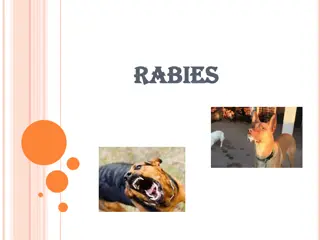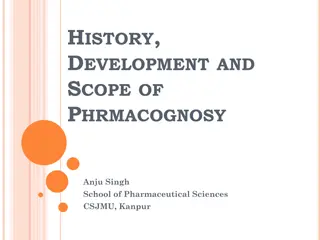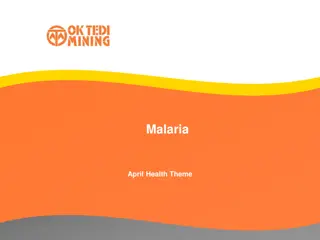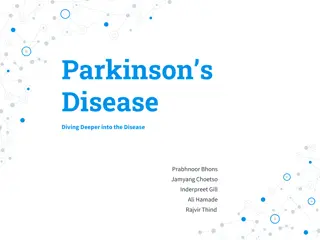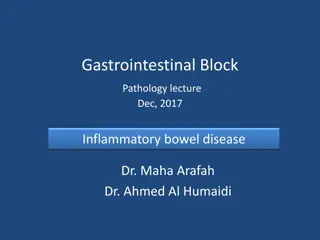Understanding the Natural History of Disease Development and Prevention
The natural history of disease development outlines the progression of a disease in an individual without intervention, from exposure to outcome. Learning objectives include defining prevention terms, understanding disease severity, prevention levels, and intervention measures. Studying disease progression is crucial for epidemiologists to prevent and control diseases effectively. Different classes of diseases are categorized based on severity, impacting reporting and prevention strategies. Recognizing the relationship between disease severity and statistics aids in identifying appropriate interventions for different disease spectrums.
Download Presentation

Please find below an Image/Link to download the presentation.
The content on the website is provided AS IS for your information and personal use only. It may not be sold, licensed, or shared on other websites without obtaining consent from the author. Download presentation by click this link. If you encounter any issues during the download, it is possible that the publisher has removed the file from their server.
E N D
Presentation Transcript
NATURAL HISTORY OF DISEASE DEVELOPMENT AND PREVENTION
LEARNING OBJECTIVES Describe the natural history of disease development Define the terms prevention, control, elimination and eradication Give examples of classes of diseases in relation to severity Explain the relation between disease severity and reporting Identify the level of prevention in relation to the natural history of disease development Identify the measures applied at each level of prevention
NATURAL HISTORY OF DISEASE It refers to the progress of a disease process in an individual over time, in the absence of intervention. It describes the course of the disease in an individual starting from the moment of exposure to the causal agents till one of the possible outcomes occurs.
NATURAL HISTORY PHENOMENON Induction Time to disease initiation Incubation Time to symptoms (infectious disease) Latency Time to detection (non-infectious diseases)
IMPORTANCE OF STUDYING THE NATURAL HISTORY OF DISEASES Understanding the progress from disease onset to final end point (cure or death) is important for epidemiologists. Knowledge of the natural history is necessary for the prevention and control of disease The intervention early in the course of the disease (asymptomatic stage) is likely to change the course of the disease favourably
CLASSES OF DISEASES IN RELATION TO CLINICAL SEVERITY (SPECTRUM OF DISEASE) Class A- INAPPARENT INFECTION FREQUENT e.g. Tuberculosis, Poliomyelitis, Hepatitis A, Meningitis, HIV.AIDS Class B- CLINICAL DISEASE FEQUENT WITH FEW DEATHS e.g. Measles, chicken pox Class C- INFECTIOUS DISEASES USUALLY FATAL e.g. Rabies, hemorrhagic fevers caused by Ebola and muberg virus Scale/ legend In-apparent Zero Mild Moderate Severe Fatal 100
RELATION BETWEEN DISEASE SEVERITY AND STATISTICS Scale/ legend In-apparent Zero Mild Moderate Severe Fatal 100 Likely to be seen by a doctor and likely to be recorded Likely to be hospitalized and recorded
PUBLIC HEALTH ASPECTS OF NATURAL HISTORY OF DISEASE AND DISEASE SEVERITY Persons with in-apparent or undiagnosed infections can transmit infections to others. Control measures must be directed toward all infections capable of being transmitted to others; both clinically apparent cases and those with in-apparent or undiagnosed infections.
PREVENTION Averting a disease or ill-health before its occurrence Control of Communicable Diseases in Men, 2013
PREVENTION Actions aiming at eradicating, eliminating, or minimizing the impact of disease and disability, or if none of these is feasible, retarding the progress of disease and disability. The concept of prevention is best defined in the context of levels of prevention; primary, secondary, and tertiary prevention. Oxford Dictionary, 2008
NATURAL HISTORY OF DISEASE AND LEVELS OF PREVENTION Stage of Subclinical Disease Stage of Clinical Disease Early Advanced Termination Stage of Susceptibility Positive health Onset of Symptoms Pathological Change Time of Diagnosis Health promotion Specific protection Early detection and treatment Disability limitation Rehabilitation Secondary prevention aims at reducing severity Primary prevention aims at reducing occurrence Tertiary prevention aims at reducing disability and mortality Levels of prevention
LEVELS OF PREVENTION Policies & legislations to address behavior of the population and environment Primordial Prevention Primary Prevention Health promotion & specific protection Secondary Prevention Screening & mass treatment Tertiary Prevention Disability limitation & rehabilitation
PRIMARY PREVENTION SPECIFIC PROTECTION HEALTH PROMOTION Immunization Health education Chemoprophylaxis Nutrition intervention Specific micronutrient Sanitation of the environment Protection from unintentional injuries Life style modification Protection from environmental hazards
DISABILITY LIMITATION & REHABILITATION Disability limitation ======= Prevent progress Rehabilitation ======= Medical rehabilitation Vocational rehabilitation Attain highest level of functional abilities Social rehabilitation Psychological rehabilitation
REFERENCES Principles of Epidemiology in Public Health Practice. Third Edition. An Introduction to Applied Epidemiology and Biostatistics. Centers for Disease Control and Prevention (CDC) Gordis L. Epidemiology. 2009






